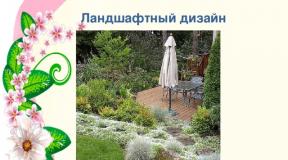School Powerpoint Presentations. History of landscape design presentation for a technology lesson on the topic Landscape design presentation
Landscape design
Fine art lesson
in 8th grade
art and drawing teacher
MBOU secondary school No. 44
Surgut, Tyumen region

Landscape design
These are practical actions for landscaping and landscaping

The main task of landscape design
Today, landscape design is a separate art, the main task of which is to create harmony and beauty in the reality around us.

Story
Versailles, France
Landscape design is a concept of the 20th century. The term originated in Western Europe, primarily in densely populated and industrialized countries: Great Britain, Germany, where mass industrialization and the growth of suburbs quickly led to pressure on the environment. Gardens and parks had to be saved, and at the same time, their garden plots had to be decorated with plantings.

Basic elements of landscape design
1. building, forming the center of the landscape project;
2. lawn covering, formed by various kinds of herbs.
3. green spaces in the form of individual trees, shrubs, flowers, as well as their combinations and entire ensembles (garden, flower bed, etc.)
4. Various decorative elements(lake, pond, stream, fountain, stones, sculpture).
5. More small artistic details(musical pendant, lamp, candles, etc.)

Landscape Design Styles
Rural (country) style - it is close to nature and rural life. In addition to decorative plants (shrubs, trees, flowers) and fruit-bearing plants. Natural materials are used for buildings, fences and roads: brick, wood, stone.

English landscape style
It almost does not use clear geometric shapes; all elements of this garden should fit seamlessly into the natural landscape. An English garden is characterized by terraces, ponds, smooth green lawns, shrubs and trees (for shady, cozy corners), and the use of water plants.

Japanese landscape style
The main thing for the Japanese style is the coordinated arrangement of stones, which will be not only a decorative element, but also a semantic one, because the Japanese garden is intended for observation and philosophical reflection. A garden in this style is characterized by the use of a huge number of stones (the central element), low-growing plants, ponds, and winding paths.

Landscape style "Modern"
The Modern landscape style is characterized by division into various functional zones. This landscape style is characterized by smooth lines and neatness. There are few plants in the Modern landscape style, but they need to be selected carefully and placed as thoughtfully as possible.

Wonders of landscape design
Maid of Mud. Heligan Garden in the UK






Practical work
Draw a sketch of the landscape on the site of a house or cottage, garden or park, on a city street.
Landscape design of a summer cottage
Landscape design at the dacha is an important element in creating a beautiful and cozy atmosphere. Before you decide what exactly you want to achieve in the end, you need to first create a plan. After determining what exactly you want, you can begin planning. To do this, a plan is created and each zone is assigned a specific design element or combination of several elements. Everything in this case depends only on your imagination, funds, as well as the availability of materials and plants.
The landscape of a summer cottage, as in principle all landscape design, is something more than just “landscaping and landscaping”. Creating gardens is a real art that has a history of more than a thousand years. Fashion changes, even styles change, but gardens remain. Unlike gardening and horticulture in their usual form, the main task of which is more agricultural (increasing productivity, etc.), landscape design is a general and even universal discipline. The main task of landscape design can be called creating beauty in combination with various amenities, beauty and the use of building infrastructure.
Water features Reservoirs and ponds in this design occupy an important place and are particularly popular. In this case, you need to decide what you want to get from the reservoirs.
Water structures For example, ideas for landscape design of a summer cottage with a water environment can be both practical and purely aesthetic in nature. That is, you can use a reservoir for some purpose, for example, use water from it to irrigate your area, or make an artificial lake that will simply please your eyes.
Water structures Choosing the type of reservoir, the required materials, as well as requirements, creating a pond with your own hands, purchasing specialized equipment and its maintenance, various plants for ponds, living creatures for reservoirs - this is all that you will need to take care of when creating a project. Landscape design of a summer cottage is not limited to standing types of reservoirs. It can also be: fountains; water mills; circulating rivers; cascades and waterfalls.
Plants and flowers Growing flowers at your dacha always requires some time and personal effort from you to create various flower beds. However, the most important thing is the desire to decorate the country landscape as competently as possible.
Plants and flowers Today there is simply a huge number of plants, as well as types of design solutions that can be used for a summer cottage. These can be classic options, such as alpine slides, or mixed or modern ones. It all depends on what style it is decided to use for the overall design.
Paths Landscape at the dacha with your own hands necessarily involves the organization of garden paths. With the help of such a seemingly simple detail, you can create a truly unique solution.
Paths The most important component in the landscape of a dacha are paths that lead to gazebos, rock gardens, sheds or a parking lot. That is, they are not only aesthetic, but also practical. Therefore, it is extremely important to think through everything down to the smallest details, and then turn them into reality.
Buildings Buildings will help you with the practical arrangement of a place for your relaxation and entertainment. The landscape design of a summer cottage, the plan of which often implies the presence of buildings, is more inclined to the fact that the buildings should be more practical in nature.
Buildings Most often, buildings can be: gazebo; terrace; tool shed; children's playground, etc. Landscaping at the dacha with your own hands involves a combination of general design and buildings, that is, you should not do everything in the Japanese style, but for example a gazebo in the European style.
Fencing is also an important element, which for the most part serves an aesthetic component, since there is no need to fence off someone on your site. In most cases, a fence that runs along the boundary with neighbors is not considered a design fence.
Fences Landscape design at the dacha using fences can also be used to separate areas of the site from each other. For example, on your site there is a garden, a vegetable garden and a recreation area. You have the opportunity to separate them from each other with decorative fences, which can be made of any material. The main thing is that the fences fit harmoniously into the overall concept. There is no point in building heavy and bulky structures, since the main task is to separate zones, and not to hide what is behind them.
Decorative elements These elements speak for themselves. They are used naturally to give your site a unique look.
Decorative elements When you decide to decorate your summer cottage, you should definitely think about this moment. Can be used as the following elements: flowerpots; lighting; decorative fountains; patio; sculptures, etc. In this case, these elements will fit perfectly into absolutely any stylistic decision, the main thing is the correct selection, which does not contradict each other.
Thank you for your attention
Landscape design
Completed by: technology teacher
Ageeva Tatyana Alekseevna

What is landscape design?
Landscape design- art located at the junction of three directions: architecture, plant growing and cultural history.
Besides, landscape design are called practical actions for landscaping and landscaping.

History of landscape development
Since ancient times, gardens have been a traditional form of organizing the surrounding space with the help of green spaces. They gained particular popularity at the courts of rulers and nobles of Eastern countries. Further, gardening as an art spread almost everywhere. At the same time, for a long time, the utilitarian nature of gardening (fruit consumption and selection of fruit trees) played an important role; later, more attention was given to the decorative nature of flowers. But neither fruit trees nor flowers are so widespread in modern landscape design, especially in its modern urban form. Landscape design is a concept of the 20th century itself. The term originated in Western Europe, primarily in densely populated and industrialized countries: Great Britain, Germany, where mass industrialization and the growth of suburbs quickly led to pressure on the environment.

Design and layout
plot
The first stage of preparing the area for landscape work begins with artistic design, that is, the creation of a plan, the basic rules of which are:
*Planting and placement of plants should be of a group nature, that is, plants of the same species or closely related species should be planted in close proximity to each other, otherwise the area will take on a scanty, deserted appearance.
* When planting plants and carrying out other artistic and design activities, straight lines should be avoided. Plants in particular are not recommended to be planted in a straight line, as this does not contribute to the development of bushiness in them. Extremely strict symmetry is also undesirable because of its unnatural appearance, although a certain balance and balanced composition of design elements must certainly be present.




Landscape Design Components
Landscape design elements are diverse. Their main groups:
* The buildings themselves, forming the center of a landscape project, the main goal of which is to smooth out, soften their pressure on the surrounding nature, remove construction waste, and disguise defects and flaws.
* Lawn covering formed by various types of grasses.
* Green spaces in the form of individual trees, shrubs, as well as their combinations and entire ensembles (garden, flower bed, ridge, etc.)
* Various large decorative elements
(lake, pond, stream, fountain, stones, sculpture).
* Smaller artistic details (light, music pendant, candles, etc.)

Green spaces
Green spaces are a collection of trees, shrubs and herbaceous plants in a certain area.
The basis and main background of all landscape design plantings is a lawn or lawn covering. They differ:
English lawn- composed of sedge and related cereal herbs; has a regular, trimmed, but somewhat unnatural appearance, quickly “bores” the eye, and is more suitable for the industrial, business and professional sports sectors.
Moorish lawn- in addition to herbs, it also includes wildflowers, has an asymmetrical and rather bright, elegant appearance, is mowed only a couple of times a year, and is more suitable for private sector buildings with an individual layout for recreational and entertainment purposes.



Shrubs
Shrubs- these are plants of medium height, usually no more than a meter. They have hard and flexible stems that begin to branch near the ground. Typically, shrubs grow in arid and hot areas, and therefore many of them have small and hard leaves, from which moisture does not evaporate so quickly, and roots that go deep into the ground are able to extract water from the lowest layers of the soil, where it is stored during drought.

Trees
Tree- life form of woody plants with a single, distinct, perennial, lignified to varying degrees, persisting throughout life, branched (except for palm trees) main axis - the trunk

Reservoirs
When creating a reservoir, the materials from which it is made play special importance. The main materials used to create reservoirs are: polyethylene, fiberglass, PVC film,
butyl rubber.

Streams and cascades
A stream is a small watercourse, usually ranging in width from several tens of centimeters to several meters. Typically, the length of the stream does not exceed several kilometers, and the depth rarely exceeds 1.5 meters.

Fountains
A fountain is a structure that serves as a base or frame for jets of water gushing up or flowing down. Initially, fountains were built primarily only as a source of drinking water. Then the combination of moving water with architecture, sculpture and green spaces became one of the means of creating various solutions in architecture and landscape art. Fountains were a favorite decoration of city squares in ancient, medieval Western European cities, in the countries of the Near and Middle East, and in India. In the 16th-18th centuries. grandiose systems of fountains were created in villas and palace and park complexes. Modern fountains are given a decorative character, which is enhanced by electric lighting and music in the evening.


Lighting organization
The creation of landscape lighting begins with a site plan where all dimensions are indicated and marked: frequently visited places, points of attraction, places that should be illuminated (paths, steps, bridges, benches), power supply points.
There are several basic techniques for landscape lighting:
* illumination from top to bottom
* illumination from bottom to top
* illumination of paths (pedestrian paths, driveways)
* backlighting (used to create silhouettes, shadows)
* spot lighting (used to attract attention)
* underwater lighting


Landscape as a health factor
urban landscape
Natural landscape
The healing effect stimulates vitality and calms the nervous system.

1 slide
Landscape design and landscaping of the site Geography teacher Tatyana Yakovlevna Khobotova Municipal educational institution secondary school No. 3 of Petrovsk, Saratov region Presentation for a panorama lesson on ecology in the 8th grade

2 slide

3 slide
Landscape ecology 8th grade. The course “Introduction to Landscape Ecology” sets the goal of forming in students an idea of the landscape as part of the geographical envelope, the components of which are interdependent. Acquaintance with the typologies and specifics of the study of landscape ecology - the natural-anthropogenic landscape and approaches to the analysis of its ecological state. It is recommended to study the course using examples of specific situations.

4 slide
Goals and objectives... Expand your horizons in landscape design Understand what landscape design is. Improve skills and abilities in working with additional material and the latest information technologies. Learn how to properly arrange and plant landscaping. Develop “your own” types of landscape design in our region.

5 slide
The role of landscape for humans The cultural landscape should be beautiful. The benefit of an aesthetic landscape is to maintain a person’s physical and spiritual health and educational potential. There are many cultural landscape ensembles in Russia (St. Petersburg, Tsarskoe Selo, Peterhof). Landscape designers work to create cultural landscapes. With the cultural landscape, the material and spiritual wealth of the nation accumulated over centuries is passed on from era to era. The cultural landscape environment grows and shapes future generations. People build and protect their native landscapes, and landscapes educate people.

6 slide

7 slide

8 slide
Recommendations for creating landscape design Landscape design of a site involves the artificial creation of an environment using natural components. Of course, much when developing a landscape design project depends on the soil, topography and climate.

Slide 9
A landscape designed in accordance with a certain style can create a special atmosphere and transport your home to another era only if the landscape design project is fully consistent with the architectural style of the house itself. As a rule, there are two main styles of landscape design - formal and landscape. In the first case, it will be a landscape design, the main elements of which are strictly defined figures; in the second, the design is designed to emphasize the natural beauty of nature.

10 slide
Today, there are a lot of elements of landscape design of a site, the use of which will create a unique landscaping of the territory. The most common of them are large-sized ones, alpine slides, flower beds and flower beds

11 slide
Irrigation system for areas Watering is essential for plants, and no matter where the water comes from, it refreshes the plants and is absorbed into the soil, carrying nutrients to the roots of the plants. Therefore, it is so important to think over the irrigation system for the site and install an automatic watering system. Of course, you can water the area with a watering can or drag hoses around the area with various nozzles, however, recently the use of an automatic watering system has become increasingly popular.

12 slide
Landscape lighting, landscape lighting design In autumn and winter, your garden quickly plunges into darkness. Landscape lighting will help you be outdoors in the evenings. In the summer twilight, landscape lighting will allow you to enjoy peace, be alone or sit with family and friends. A competent landscape lighting design for your site will make any corner of it accessible at any time of the day. Landscape lighting uses both tall lanterns and directional lighting. There are different types of landscape lighting controls.

Slide 13
Landscaping and landscaping When choosing seedlings for landscaping the area, try to imagine how harmoniously their foliage will fit into the overall palette of the site: will it shade it beautifully, will it be able to match the color, shape and color intensity with the landscape

Slide 14
Finishing with natural stone Finishing with natural stone will emphasize the beauty of your home and the area adjacent to it and unite all the details into a single whole. We use natural stone finishing in landscape work in almost all areas. Using natural stone in its natural or processed form, you can decorate the facade or basement of a house, or decorate a fireplace room or winter garden with natural stone. And the landscape of your site using natural stone to design winding paths, rock gardens and ponds, grottoes, and waterfalls will be especially expressive.

15 slide
Creating flower beds, decorating flower beds Creating flower beds and decorating flower beds can make any garden more interesting. You can achieve extraordinary and long-lasting flowering of the garden - after all, in addition to snowdrops, chionodoxes and hellebores bloom in early spring, and autumn crocuses, crocuses and some cyclamen see off the year. Everywhere there is a huge variety of seeds of annuals, perennials for mixborders, plants for rockeries, and bulbs. Of course, you can create flower beds and design flower beds yourself. But this time-consuming, painstaking task can take up all your free time.

16 slide
In order to get a spectacular flowerbed or lawn, it is necessary to select plants in such a way that they are not only nearby, but also have similar “tastes” (temperature, light, air humidity). Thus, one of the secrets of successful landscaping is correctly selected plants that will meet all the goals set. The more suitable conditions are provided for plants, the better they will develop, and, therefore, the longer they will decorate your site.

Slide 17
Landscape styles The regular style of park landscape, which is often called French, is the brainchild of the era of absolutism. The basic principle of a regular style in landscape design is order and regularity in everything. A French-style park is built according to a single plan, subordinated to a certain general idea. All the lines of this park are geometrically correct, its paths are usually straight, and if not, then the lines of their bends are drawn on the plan using a compass.

18 slide
Chinese landscape style The traditional Chinese garden is called a reflection of the soul of its owner. And just as the human soul is unique, so is the appearance of the garden. It can embody elements of local tradition, the philosophical and religious views of the owner or creator of the garden, and the characteristics of his personal character. In a Chinese-style garden, it is very difficult to determine the line between artificial and natural, between the creation of human hands and nature. The Chinese garden always strives for perfection, for the ideal in the relationship between land and water, hills and plains, plants and open space. The main principles of a Chinese garden are hierarchy and harmony. Therefore, in the landscape of a Chinese garden there is always a certain center, a key composition, to which other elements are subordinate.

Slide 19
It can occupy a corner or niche inside or outside the house and extend a couple of steps from the wall. And the size of the trees will match the size of the garden - but these will be real mature trees. The art of growing them is also part of the Japanese tradition, and today such dwarf trees, called bonsai, are also known throughout the world. But in Europe they are most often grown in pots on the windowsill, and in Japan they can be part of a full-fledged garden. Japanese garden In a Japanese garden there is never anything excessive, pretentious, or standing out from the general background. There is no riot of colors or bizarre variety of plants here. And at the same time, there is nothing secondary or redundant here that you can do without. A Japanese garden may consist of one tree. Or from several trees located in accordance with a certain philosophical idea, which can only be comprehended through meditation.



















